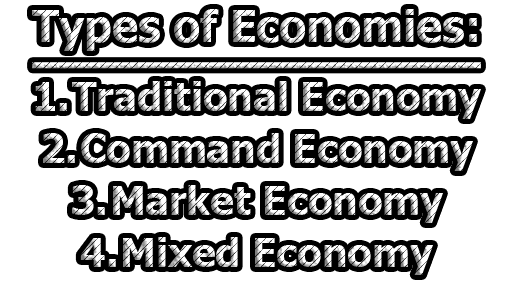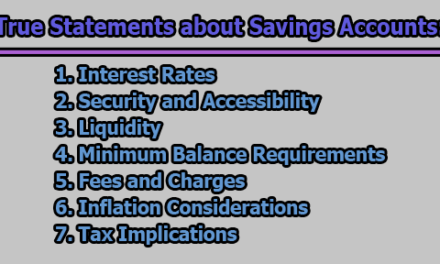The economy is the complex system of production, distribution, exchange, and consumption of goods and services in a society. It is a critical aspect of society as it determines the standard of living, level of economic activity, and overall growth and development of a country. The economy is often divided into various sectors such as agriculture, industry, and services, and it is driven by various factors such as consumer demand, government policy, technological advancements, and global events. The performance of an economy is measured using various metrics such as gross domestic product (GDP), employment rates, inflation, and trade balances. In the rest of this article, we are going to present you with a brief basic idea about types of economies and economic indicators.
Types of Economies:
There are several types of economies, which can be broadly classified into four categories: traditional, command, market, and mixed. Let’s take a closer look at each of these categories:
- Traditional Economy: In a traditional economy, the ways of production and distribution of goods and services are passed down from one generation to another and are based on customs, beliefs, and traditions. These economies are usually agricultural and rely on subsistence farming, hunting, and gathering. Decision-making is usually based on cultural norms and the allocation of resources is done through bartering or sharing.
- Command Economy: A command economy, also known as a planned economy, is one in which the government makes all economic decisions and controls the means of production. The government decides what goods and services will be produced, how they will be produced, and for whom they will be produced. In a command economy, the allocation of resources is done through a central planning authority, and prices are set by the government.
- Market Economy: A market economy is based on the principles of supply and demand. In a market economy, the prices of goods and services are determined by the interaction of buyers and sellers in a competitive market. Market economies are characterized by private property rights, freedom of choice, and the ability to buy and sell goods and services. The allocation of resources is done through the market mechanism and the role of the government is limited to enforcing property rights and providing a stable legal framework.
- Mixed Economy: A mixed economy is a combination of a market economy and a command economy. In a mixed economy, both the government and the market play a role in the allocation of resources. The government may provide certain public goods and services, regulate certain industries, and redistribute income through taxation and transfer programs. The market, on the other hand, determines the prices of goods and services and allocates resources based on supply and demand.
So, we can say that different types of economies have different characteristics and goals, and the choice of a particular type of economy can have a significant impact on the overall performance of an economy. Understanding the different types of economies and the factors that influence their development is important for policymakers, economists, and investors alike.
Economic Indicators:
Economic indicators are statistics that measure various aspects of an economy and provide insight into its performance and health. Some of the most common economic indicators include:
i. Gross Domestic Product (GDP): GDP is the total value of goods and services produced within a country’s borders over a specified time period, usually a quarter or a year. It is used as a measure of a country’s economic growth and is one of the most widely watched economic indicators.
ii. Consumer Price Index (CPI): The Consumer Price Index measures changes in the prices of goods and services purchased by consumers. It is used as a measure of inflation and provides insight into the changes in the cost of living.
iii. Unemployment rate: The unemployment rate is the percentage of the labor force that is without work but actively seeking employment. It is a measure of the health of the labor market and provides insight into the level of job creation in an economy.
iv. Retail Sales: Retail sales measure the total sales of goods and services at the retail level. It provides insight into consumer spending, which is a critical driver of economic growth.
v. Housing Starts: Housing starts measure the number of new residential construction projects that have started in a given period. They provide insight into the health of the housing market and are a good indicator of economic growth.
vi. Industrial Production: Industrial production measures the output of the industrial sector, which includes manufacturing, mining, and utilities. It provides insight into the strength of the industrial sector and the overall health of the economy.
vii. Inflation (or Deflation): Inflation and deflation are important indicators of the health of an economy.
Inflation refers to a sustained increase in the general price level of goods and services in an economy over a period of time. When prices rise, the purchasing power of money decreases and inflation can have a variety of negative effects, such as reducing the value of savings and reducing consumers’ ability to purchase goods and services. High levels of inflation can also lead to increased uncertainty and decreased economic activity.
Deflation, on the other hand, refers to a sustained decrease in the general price level of goods and services in an economy over a period of time. When prices fall, the purchasing power of money increases, but deflation can also have negative consequences, such as reducing demand for goods and services and leading to decreased economic activity.
Central banks use monetary policy to try to manage inflation and deflation. For example, if inflation is too high, a central bank may increase interest rates to reduce demand and slow down the economy. If inflation is too low or there is deflation, a central bank may lower interest rates to increase demand and stimulate economic activity.
In general, low and stable inflation is considered healthy for an economy, as it provides a stable environment for economic growth and job creation. Extreme levels of inflation or deflation can signal economic imbalances and indicate a need for monetary policy adjustments.
viii. Balance of Trade: The balance of trade measures the difference between a country’s exports and imports. A positive balance of trade indicates that a country is exporting more than it is importing, while a negative balance of trade indicates the opposite.
ix. Stock Market Indices: Stock market indices, such as the Dow Jones Industrial Average and the S&P 500, measure the performance of the stock market and provide insight into the health of the financial sector and the overall economy.
In conclusion, Economic indicators provide a means of measuring the health and performance of an economy, and tracking changes in these indicators can help to identify trends and potential problems. Inflation and deflation are two important economic indicators that can have a significant impact on an economy. Low and stable inflation is generally considered a positive sign, while extreme levels of inflation or deflation can signal economic imbalances and the need for policy adjustments. In order to make informed decisions, it is important to consider a range of economic indicators and to understand the relationships between them. By doing so, economists, policymakers, and investors can gain a comprehensive picture of the state of an economy and make informed decisions that can contribute to its growth and stability.

Assistant Teacher at Zinzira Pir Mohammad Pilot School and College










